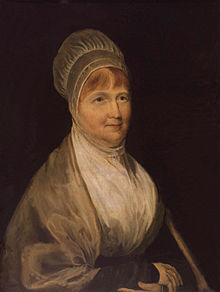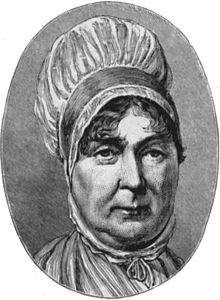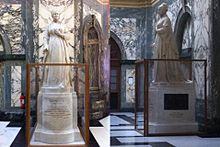- Elizabeth Fry
-
Elizabeth Fry 
Elizabeth FryBorn Elizabeth (Betsy) Gurney
21 May 1780
Norwich, EnglandDied 12 October 1845 (aged 65)
Ramsgate, EnglandSpouse Joseph Fry (19 August 1800 – 12 October 1845) (11 children) Elizabeth (Betsy) Fry (21 May 1780 – 12 October 1845), née Gurney, was an English prison reformer, social reformer and, as a Quaker, a Christian philanthropist. She has sometimes been referred to as the "angel of prisons".
Fry was a major driving force behind new legislation to make the treatment of prisoners more humane, and she was supported in her efforts by the reigning monarch. Since 2001, she has been depicted on the Bank of England £5 note.
Contents
Birth and family background
Elizabeth (Betsy) Gurney was born in Gurney Court, off Magdalen Street, Norwich, Norfolk, England to a Quaker family. Her family home as a child was Earlham Hall, which is now part of the University of East Anglia.[1] Her father, John Gurney, was a partner in Gurney's bank. Her mother, Catherine, was a part of the Barclay family, who were among the founders of Barclays Bank. Her mother died when Elizabeth was only twelve years old. As one of the oldest girls in the family, Elizabeth was partly responsible for the care and training of the younger children, including her brother Joseph John Gurney, a philanthropist. One of her sisters was Louisa Gurney Hoare (1784–1836), a writer on education.
Awakening of social concern
At the age of 18, young Elizabeth was deeply moved by the preaching of William Savery, an American Quaker. Motivated by his words, she took an interest in the poor, the sick, and the prisoners. She collected old clothes for the poor, visited those who were sick in her neighbourhood, and started a Sunday school in the summer house to teach children to read.
She met Joseph Fry (1777 – 1861), a banker and also a Quaker, when she was twenty years old. They married on 19 August 1800 at the Norwich Goat Lane Friends Meeting House and moved to St Mildred's Court in the City of London. Elizabeth Fry was recorded as a Minister of the Religious Society of Friends in 1811.
Joseph and Elizabeth Fry lived in Plashet House in East Ham between 1809 and 1829, then moved to Upton Lane in Forest Gate. They had eleven children, five sons and six daughters:
- John Gurney Fry of Warley Lodge, born 1804 died 1872, married Rachel Reynolds, whose mother was a Barclay
- William Storrs Fry born 1 June 1806, died 1844, married Juliana Pelly
- Joseph Fry born 20 September 1809, died 1896, married Alice Partridge
- Samuel Fry born 1816 (known as “Gurney”), died 1902, married Sophia Pinkerton
- Daniel Fry, known as "Henry" or "Harry", born October 1822 died 1892, married Lucy Sheppard
- Katharine (Kitty) Fry born 22 August 1801, unmarried, who wrote a History of the Parishes of East and West Ham
- Rachel Elizabeth Fry born 25 March 1803 died 4 Dec 1888, married Francis Cresswell
- Richenda Fry born 18 February 1808, died 1884, married Foster Reynolds
- Elizabeth (Betsy) Fry born February 1811, died 1815
- Hannah Fry born on 12 September 1812 died on 10th March 1895, married Rev William Champion Streatfeild
- Louisa Fry born 1814, died 1896, married Raymond Pelly (brother of Juliana, William’s wife)
Prison work
Prompted by a family friend, Stephen Grellet, Fry visited Newgate prison. The conditions she saw there horrified her. The women's section was overcrowded with women and children, some of whom had not even received a trial. They did their own cooking and washing in the small cells in which they slept on straw. Elizabeth Fry wrote in the book Prisons in Scotland and the North of England that she actually stayed the nights in some of the prisons and invited nobility to come and stay and see for themselves the conditions prisoners lived in. Her kindness helped her gain the friendship of the prisoners and they began to try to improve their conditions for themselves.
She returned the following day with food and clothes for some of the prisoners. She was unable to further her work for nearly four years because of difficulties within the Fry family, including financial difficulties in the Fry bank. Fry returned in 1816 and was eventually able to found a prison school for the children who were imprisoned with their parents. She began a system of supervision and required the women to sew and to read the Bible. In 1817 she helped found the Association for the Reformation of the Female Prisoners in Newgate. This led to the eventual creation of the British Ladies' Society for Promoting the Reformation of Female Prisoners, widely described by biographers and historians as constituting the first "nationwide" women's organization in Britain.
Thomas Fowell Buxton, Fry's brother-in-law, was elected to Parliament for Weymouth and began to promote her work among his fellow MPs. In 1818 Fry gave evidence to a House of Commons committee on the conditions prevalent in British prisons, becoming the first woman to present evidence in Parliament.
Other humanitarian work
Elizabeth Fry also helped the homeless, establishing a "nightly shelter" in London after seeing the body of a young boy in the winter of 1819/1820. In 1824, during a visit to Brighton, she instituted the Brighton District Visiting Society. The society arranged for volunteers to visit the homes of the poor and provide help and comfort to them. The plan was successful and was duplicated in other districts and towns across Britain.
After her husband went bankrupt in 1828, Fry's brother became her business manager and benefactor. Thanks to him her work went on and expanded.
In 1840 Fry opened a training school for nurses. Her programme inspired Florence Nightingale, who took a team of Fry's nurses to assist wounded soldiers in the Crimean War.
Reputation
Fry became well known in society. Some people criticized her for having such an influential role as a woman. Others alleged that she was neglecting her duties as a wife and mother in order to conduct her humanitarian work. One admirer was Queen Victoria, who granted her an audience a few times and contributed money to her cause. Another admirer was Robert Peel who passed several acts to further her cause including the Gaols Act 1823 (unfortunately this act did not have much enforcement as most laws of this kind were at the time)[clarification needed]
Following her death in 1845, a meeting chaired by the Lord Mayor of London, resolved that it would be fitting "to found an asylum to perpetuate the memory of Mrs Fry and further the benevolent objects to which her life had been devoted." * A fine 18th century town house was purchased at 195 Mare Street, in the London Borough of Hackney and the first Elizabeth Fry refuge opened its doors in 1849. Funding came via subscriptions from various city companies and private individuals, supplemented by income from the inmates laundry and needlework. Such training was an important part of the refuge's work. In 1924, the refuge merged with the Manor House Refuge for the Destitute, in Dalston in Hackney, becoming a hostel for girls on probation for minor offences. The hostel soon moved to larger premises in Highbury, Islington and then, in 1958, to Reading, where it remains today. The original building in Hackney became the CIU New Lansdowne Club but became vacant in 2000 and has fallen into disrepair. Hackney Council, in 2009, is leading efforts to restore the building and bring it back into use. The building and Elizabeth Fry are commemorated by a plaque at the entrance gateway.
Death
Elizabeth Fry died from a stroke in Ramsgate, England, on 12 October 1845. Her remains were buried in the Friends' burial ground at Barking. Until this occasion, the Seamen of the Ramsgate Coast Guard flew their flag at half mast in respect of Mrs Fry; a practice reserved officially for the death of a ruling monarch.[2] More than a thousand people stood in silence during the burial.
Memorials
Two plaques commemorate her birthplace, at Smith Court, off Magdalen Street, Norwich, and her childhood home of Earlham Hall. There is also an Elizabeth Fry Road in Earlham. There is another plaque at St. Mildred's Court, City of London, where she lived when she was first married, which in turn is commemorated in St. Mildred's Road in Earlham.
On the campus of The University of East Anglia there is a modern building named in her honour, it is home to the university's School of Social Work and Psychology and is used many other schools for general teaching.
There is a stone statue of her in the Old Bailey.
A plaque has been placed at the site of Arklow House, her home and place of death in Ramsgate by the Ramsgate Society.
Her resting place at the former Society of Friends Burial Ground, off Whiting Avenue in Barking, Essex, was restored and on 8 October 2003, a new commemorative plinth made of marble was officially unveiled.
Elizabeth Fry is also depicted on two panels of the Quaker Tapestry, panels E5 and E6.
In February 2007 a new plaque was placed in her honour on the Friends Meeting House in Upper Goat Lane, Norwich.
The Canadian Association of Elizabeth Fry Societies honours her memory by advocating for women who are in the criminal justice system. They also celebrate and promote a National Elizabeth Fry Week in Canada each May.
Since 2001 Fry has been depicted on the reverse of £5 notes issued by the Bank of England. She is shown reading to prisoners at Newgate Prison. The design also incorporates a key, representing the key to the prison which was awarded to Fry in recognition of her work.[3]
There is an Elizabeth Fry Ward in Scarborough Hospital in North Yorkshire, United Kingdom.
In the Lady Chapel of Manchester's Anglican Cathedral one of the portrait windows of Noble Women on the West wall of the Chapel features Elizabeth Fry.
On the former British television series Rumpole of the Bailey, a replica of the Elizabeth Fry statue in the Old Bailey is featured prominently in scenes set in the lobby.
There is a bust of Elizabeth Fry located in the Study Area of East Ham Library, Newham Borough of London.
See also
Notes
- ^ Earlham Hall as part of University of Easy Anglia
- ^ 'Memoirs of Mrs. Elizabeth Fry' (second edition) by Rev. Thomas Timpson. London : Aylott and Jones, 1847
- ^ "Current Banknotes £5 Note (Elizabeth Fry)". Bank of England. http://www.bankofengland.co.uk/banknotes/current/current_5.htm. Retrieved 2008-10-19.
References
- Anderson, George M. "Elizabeth Fry: timeless reformer." America 173 (Fall 1995): 22-3.
- Clay, Walter Lowe. The Prison Chaplain. Montclair. New Jersey.: Patterson Smith, 1969.
- Fairhurst, James. "The Angel of Prisons." Ireland's Own 4539 (Fall 1996):5.
- Fry, Katherine. Memoir of the Life of Elizabeth Fry. Montclair, N.J.: Patterson Smith, 1974. Second edition, 1848 available on GoogleBooks.
- Hatton, Jean. Betsy, the dramatic biography of a prison reformer. Oxford UK & Grand Rapids, Michigan, Monarch Books, 2005. (ISBN 1-85424-705-0 (UK), ISBN 0-8254-6092-1 (USA)).
- Johnson, Spencer. The Value of Kindness: The Story of Elizabeth Fry. 2nd ed. 1976. (ISBN 0-916392-09-0)
- Lewis, Georgina. Elizabeth Fry. London, England: Headley Brothers, 1909.
- Francisca de Haan, ‘Fry , Elizabeth (1780–1845)’ in Oxford Dictionary of National Biography [1], accessed 21 May 2009.
- Pitman, E.R. Elizabeth Fry. Boston, Mass.: Roberts Brothers, 1886.
- Rose, June. Elizabeth Fry, a biography. London & Basingstoke: Macmillan, 1980. (ISBN 0-333-31921-4) reprinted 1994 by Quaker Home Service ISBN 0852452608.
- Rose, June. Prison Pioneer: The Story of Elizabeth Fry. Quaker Tapestry Booklets, 1994.
- Whitney, Janet. Elizabeth Fry: Quaker Heroine. London UK: George Harrap & Co. Ltd., 1937, New York, N.Y.: Benjamin Blom, Inc., 1972.
- www,hackney.gov.uk/archives
External links
- Earlham Hall at the University of England (UEA)
- Bank of England Website five pound note
- A sermon by Elizabeth Fry
- BBC - The five pound question: Who is Elizabeth Fry?
- Bank of England Website Fry's Portrait
- Association of Elizabeth Fry Societies
- Council of Elizabeth Fry Societies of Ontario
- Société Elizabeth Fry du Québec Canada
- Archival material relating to Elizabeth Fry listed at the UK National Register of Archives
- Quakers around Shoreditch
- Howard League for Penal Reform
Religious Society of Friends Quakers List of Quakers · Anthony Benezet · Kenneth E. Boulding · Margaret Fell · George Fox · Elizabeth Fry · Edward Hicks · Elias Hicks · Rufus Jones · Lucretia Mott · William Penn · Robert Pleasants · John Greenleaf Whittier · John Woolman
Groups Testimonies Peace · Equality · Integrity · Simplicity
Other Businesses, organizations and charities · Clerk · History · Homosexuality · Inner light · Meeting houses · Query · Schools · Tapestry · Wedding · Women
Categories:- 1780 births
- 1845 deaths
- Anglican saints
- Female saints
- English activists
- English suffragists
- English humanitarians
- English nurses
- English Quakers
- Fry family
- Penal system in England
- Penal system in the United Kingdom
- People from Norwich
- People from Ramsgate
- People illustrated on sterling banknotes
- 19th-century Christian saints
Wikimedia Foundation. 2010.


